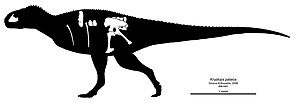Kryptops
Kryptops is a genus of abelisaurid theropod dinosaur from the Early Cretaceous of Niger. It is known from a partial skeleton found at the Gadoufaoua locality in the western Ténéré Desert, in rocks of the Aptian–Albian-age Elrhaz Formation. This dinosaur was described by paleontologists Paul Sereno and Stephen Brusatte in 2008. The genus name means "covered face", in reference to evidence that the face bore a tightly adhering covering. The type species is K. palaios, which means "old".
| Kryptops Temporal range: Early Cretaceous, | |
|---|---|
 | |
| Skeletal diagram showing the holotype maxilla of the upper jaw in place, the postcrania is based on remains that cannot be confidently attributed to the animal. | |
| Scientific classification | |
| Domain: | Eukaryota |
| Kingdom: | Animalia |
| Phylum: | Chordata |
| Clade: | Dinosauria |
| Clade: | Saurischia |
| Clade: | Theropoda |
| Family: | †Abelisauridae |
| Genus: | †Kryptops Sereno & Brusatte, 2008 |
| Type species | |
| †Kryptops palaios Sereno & Brusatte, 2008 | |
Discovery



The holotype skeleton, MNN GAD1, includes a maxilla (main tooth-bearing bone of the upper jaw), vertebrae, ribs, and articulated pelvic girdle and sacrum, belonging to an adult about 6–7 m (19.7–23.0 ft). According to the describers, this specimen represents one of the earliest-known abelisaurids, and is notable for the heavily textured surface of the maxilla; the presence of pits and impressions of blood vessels indicates that there was a covering firmly attached to the face, perhaps of keratin. Sereno and Brusatte performed a cladistic analysis that found Kryptops to be the most basal abelisaurid. This was based on several features, including a maxilla textured externally by impressed vascular grooves and a narrow antorbital fossa, that clearly place Kryptops palaios within Abelisauridae as its oldest-known member. In 2012 Matthew Carrano and colleagues, on the other hand, considered Kryptops palaios to be a chimera, and state that its postcranial remains (especially a pelvis and sacrum), found some 15 metres from the holotypic maxilla, actually belong to a carcharodontosaurid (possibly to Eocarcharia dinops).
See also
References
This article uses material from the Wikipedia English article Kryptops, which is released under the Creative Commons Attribution-ShareAlike 3.0 license ("CC BY-SA 3.0"); additional terms may apply (view authors). Content is available under CC BY-SA 4.0 unless otherwise noted. Images, videos and audio are available under their respective licenses.
®Wikipedia is a registered trademark of the Wiki Foundation, Inc. Wiki English (DUHOCTRUNGQUOC.VN) is an independent company and has no affiliation with Wiki Foundation.
